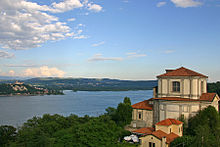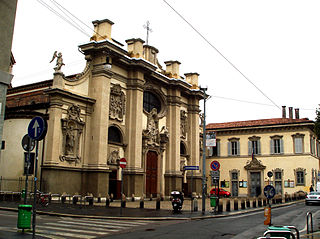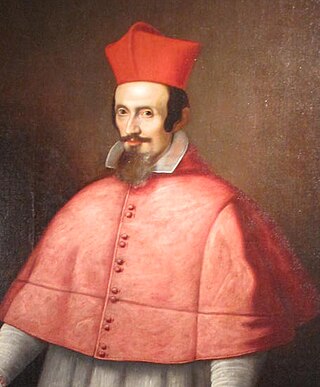The Sacro Monte di Arona, devoted to Charles Borromeo, is part of the Sacri Monti built in the 16th and 17th centuries. It is located in the territory of the town of Arona, province of Novara, region of Piedmont, Italy.
Contents


The Sacro Monte di Arona, devoted to Charles Borromeo, is part of the Sacri Monti built in the 16th and 17th centuries. It is located in the territory of the town of Arona, province of Novara, region of Piedmont, Italy.


Around 1610 (when Charles Borromeo was canonized) father Marco Aurelio Grattarola had the idea of building a Sacro Monte devoted to Saint Charles on a hill behind his native town. The work was intended to celebrate the archbishop of Milan in the territory of his family.
The greatness of the figure inspired the idea of a huge statue visible from the opposite side of the Lake Maggiore. The initiative received the support of Federico Borromeo, who succeeded the cousin as archbishop of Milan.
The architect Francesco Maria Richini was charged with the project. He proposed an ambitious project, only partially realised. Starting with a triumphal arch, three paths should have started, each one with five chapels illustrating the life of Saint Charles and his spirituality.
In July 1614 Federico Borromeo celebrated the start of the construction. One of the first buildings to be completed was the church, designed by Richini as a central plan church.
Only a few chapels were built. Today only three remain, but without the decorations. For the realisation of the statues artists involved in the construction of the Sacro Monte di Varallo came.
The death of father Grattarola in 1615, the plague of 1629-1631 and the death of Federico Borromeo in 1631 interrupted the works. Only in 1692, the Borromeo family started again the construction. The new project, made by the architect Carlo Fontana, was far more modest than the original.
The sanctuary was completed only in 1725 with the building of the roof. Today over the main altar there is a painting by Giulio Cesare Procaccini; behind the altar has been reconstructed the original room of Saint Charles with the furniture coming from the Rocca Borromea nearby.
In front of the church, on the opposite side of the square, is " Saint Charles' seminary". From the square, a stairway takes you to the colossal statue of Saint Charles. The statue's design was made by Giovanni Battista Crespi, called il Cerano.
The statue, 28 m in height, commonly called Sancarlone , was realised in 1698. It is an empty structure made of wrought copper. It is possible to climb up to the head thanks to an inner stairway. Only the Statue of Liberty is a taller metal statue.

Milan Cathedral, or Metropolitan Cathedral-Basilica of the Nativity of Saint Mary, is the cathedral church of Milan, Lombardy, Italy. Dedicated to the Nativity of St. Mary, it is the seat of the Archbishop of Milan, currently Archbishop Mario Delpini.

Charles Borromeo was the Archbishop of Milan from 1564 to 1584 and a cardinal of the Catholic Church. He was a leading figure of the Counter-Reformation combat against the Protestant Reformation together with Ignatius of Loyola and Philip Neri. In that role he was responsible for significant reforms in the Catholic Church, including the founding of seminaries for the education of priests. He is honoured as a saint by the Catholic Church, with a feast day on 4 November.

Arona is a town and comune on Lake Maggiore, in the province of Novara. Its main economic activity is tourism, especially from Milan, France and Germany.

Federico Borromeo was an Italian cardinal and Archbishop of Milan, a prominent figure of Counter-Reformation Italy.

The Sacri Montiof Piedmont and Lombardy are a series of nine calvaries or groups of chapels and other architectural features created in northern Italy during the late sixteenth century and the seventeenth century. They are dedicated to various aspects of the Christian faith and are considered of great beauty by virtue of the skill with which they have been integrated into the surrounding natural landscape of hills, forests and lakes. They also house important artistic materials in the form of wall paintings and statuary. In 2003, they were named as a World Heritage Site.

The aristocratic House of Borromeo were merchants in San Miniato around 1300 and became bankers in Milan after 1370. Vitaliano de' Vitaliani, who acquired the name of Borromeo from his uncle Giovanni, became the count of Arona in 1445. His descendants played important roles in the politics of the Duchy of Milan and as cardinals in the Catholic Reformation. In 1916 the head of the family was granted the title Prince of Angera by the King of Italy.

Francesco Maria Richini was an Italian Baroque architect.

Pier Francesco Mazzucchelli was an Italian painter and draughtsman who was active in Milan. He is mainly known for his altarpieces, but his outstanding achievements are large decorative frescoes for the Sacro Monte di Varese and the Sacro Monte di Varallo.

Giuseppe Rusnati was a Lombard sculptor of the Rococo period. Known for having trained with Ercole Ferrata and subsequently from 1673 to c. 1686 training a young Camillo Rusconi, prior to the latter's relocation himself to Ferrata's studio in Rome. Born near Como; he died in 1713. He worked for many years for the Duomo of Milan, where he worked along with Giuseppe Buono (1670–1709/21) and Carlo Simonetta.

Antonio d'Enrico, called Tanzio da Varallo, or simply il Tanzio was an Italian painter of the late-Mannerist or early Baroque period.

The Sacred Mountain of Varallo is a Sacro Monte overlooking the town of Varallo Sesia in the province of Vercelli, Piedmont, northern Italy. It is the oldest Sacro Monte, founded in 1491 by Franciscan friar Bernardino Caimi. It is built on a natural terrace on the rocky slopes of Monte Tre Croci, on the left bank of the Sesia river where it leaves Val Mastallone. It is 600 m above sea level, 150 m above the historic centre of Varallo.

The Sacro Monte di Orta is a Roman Catholic devotional complex in the comune of Orta San Giulio on the summit of a hill known as San Nicolao, which faces the western shore of Lake Orta. It is one of the Sacri Monti of Piedmont and Lombardy, included in UNESCO World Heritage list.

The Sacro Monte di Oropa is a Roman Catholic devotional complex in the province of Biella, Piedmont, northern Italy. It is one of the nine Sacri Monti of Piedmont and Lombardy and is on the UNESCO World Heritage list.

Cesare Monti was an Italian Cardinal who served as Latin Patriarch of Antioch and Archbishop of Milan.

The Sacro Monte di Varese is one of the nine sacri monti in the Italian regions of Lombardy and Piedmont which were inscribed on the UNESCO list of World Heritage Sites in 2003. It has an altitude of 807 metres above sea level.

The San Carlone or Sancarlone or the Colossus of San Carlo Borromeo is a massive copper statue, erected between 1614 and 1698, near Arona, Italy. It represents Charles Borromeo, Catholic saint and former archbishop of Milan. According to Bartholdi "The statue of St. Charles Borromeo is the first known example of a statue of repousse copper, worked with the hammer inside and outside, and freely supported on iron beams". Today, the complex is maintained by Milan’s Biblioteca Ambrosiana.
CoEur is a Christian devotional and hiking route in Italy and Switzerland. Its Italian subtitle, Nel cuore dei cammini d'Europa, translates as "In the heart of Europe's paths".
The Path of Saint-Charles is an historical, artistic and devotional route which follows the travels of saint Charles Borromeo from Arona, his native town, and Viverone, where the path joins the Via Francigena.
The Sacro Monte di Graglia is one of the numerous devotional places around the Italian Alps and it houses the Santuario di Nostra Signora di Loreto, one of the four major sanctuaries of the Biellese territory. Set in the Valle Elvo at 690 m on the sea level, the sanctuary is built near the Lauretana water industry.
The Sacro Monte del Santuario di San Giovanni Battista d'Andorno is the Sacro Monte built around a sanctuary in the Cervo Valley above the village of Campiglia Cervo, at an altitude of 1020 meters. It is the only sanctuary devoted to Saint John in Italy and probably in Europe.